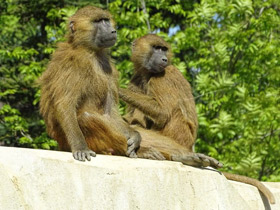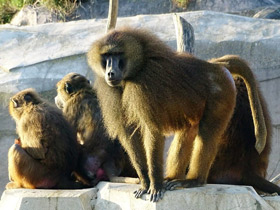The Guinea baboon (Papio papio)
The Guinea baboon (Papio papio) is a baboon from the Old World monkey family. Some (older) classifications list only two species in the genus Papio, this one and the hamadryas baboon. In those classifications, all other Papio species are considered subspecies of P. papio and the species is called the savanna baboon.
Habitat and appearance
Papio papio is a species of catarrhine primate of the family Cercopithecidae. Papio papio inhabits a small range in West Africa. Its range includes Guinea, Senegal, Gambia, southern Mauritania and western Mali.
Papio papio is the least studied baboon species. It is distinguished by its reddish-brown fur and a small mane growing around the head. This mane is probably the reason why the Guinea turkey is called the sphinx turkey. It has a reddish-brown coat and a hairless, dark purple or black snout, typical of the Pavia species. Papio papio is the smallest of the baboon species: its body length varies from 65 to 90 cm, and its weight from 14 to 26 kg (males are larger than females).
Lifestyle and nutrition
Papio papio are active during the day and climb trees to sleep at night. They are the least of the pure species that are active during the day, moving mainly on the ground. At night they prefer to roost in trees. The presence of suitable trees for roosting limits the size of the group and the extent of their range.
Like their relatives, they are omnivorous and feed mainly on succulent fruits, young shoots, roots and bulbs of plants. They also catch insects, ravage bird nests by eating their eggs and chicks, and sometimes hunt small mammals.
Social behaviour and reproduction
Little is known about the social behaviour of these animals, but they probably live, like other baboons, in harem-like groups.
Although these animals are little known due to their limited habitat, they are known to keep themselves in groups of 20 to 40 individuals. Papio papio breed throughout the year, without any seasonality. Females can become pregnant at 3.5-4 years, males reach sexual maturity at 5-6 years. The average gestation time of Papio papio is 220-250 days. Twin births are quite rare in these apes. The offspring, black at birth, begins to turn lighter in colour after two months of life. Papio papio can live 40 years or more.
Ecology
Guinea baboons are diurnal, living on the ground instead of in trees, and typically sleep in trees at the terminal ends of branches. Their group size is widely variable and ranges from 30 to 200. However, the most common troop size is 30-40 individuals. Often, a pronounced male hierarchy and fierce competition for females happens within the group. This competition leads to sexual dimorphism among the species. When it comes to feeding, they are independent foragers, and females are always paired with males when foraging so they can be protected. Females may choose to follow the same males from year to year.
Papio papio on the Red List
Due to its reduced range and the destruction of its natural habitat, Papio papio has become rare. The species is listed as Near Threatened on the IUCN Red List.

















































